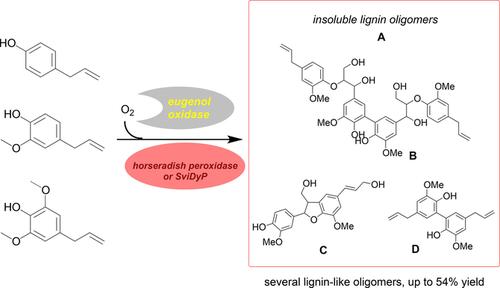当前位置:
X-MOL 学术
›
Adv. Synth. Catal.
›
论文详情
Our official English website, www.x-mol.net, welcomes your feedback! (Note: you will need to create a separate account there.)
A Biocatalytic One-Pot Approach for the Preparation of Lignin Oligomers Using an Oxidase/Peroxidase Cascade Enzyme System
Advanced Synthesis & Catalysis ( IF 5.4 ) Pub Date : 2017-09-14 04:45:49 , DOI: 10.1002/adsc.201700650 Mohamed H. M. Habib 1, 2 , Peter J. Deuss 3 , Nikola Lončar 4 , Milos Trajkovic 1 , Marco W. Fraaije 1
Advanced Synthesis & Catalysis ( IF 5.4 ) Pub Date : 2017-09-14 04:45:49 , DOI: 10.1002/adsc.201700650 Mohamed H. M. Habib 1, 2 , Peter J. Deuss 3 , Nikola Lončar 4 , Milos Trajkovic 1 , Marco W. Fraaije 1
Affiliation

|
Synthetic lignin was prepared biocatalytically in a one-pot, two-step reaction using an oxidase/peroxidase cascade enzyme system. Using eugenol in combination with eugenol oxidase and a peroxidase, lignin-like material was produced. The cascade reaction takes advantage of the ability of the oxidase to produce coniferyl alcohol and hydrogen peroxide from eugenol and molecular oxygen. The hydrogen peroxide is used by the peroxidase for the formation of crosslinks that typify lignin. As eugenol oxidase has a broad substrate acceptance profile, also 4-allylphenol (chavicol) and 4-allyl-2,6-dimethoxyphenol could be used as precursors of the synthetic lignin. As a result, all three naturally occurring monolignols could be prepared and incorporated in the synthetic lignin. The reaction was optimized in order to achieve the highest possible yield of insoluble lignin oligomers and scaled up to 1 gram. Analysis of the water-insoluble product by gel permeation chromatography revealed the formation of relatively small lignin oligomers (≈1000 dalton). By using two-dimensional heteronuclear single quantum coherence nuclear magnetic resonance spectroscopy (2D HSQC NMR) analysis it could be demonstrated that the material contained α-O-4/β-O-4, β-O-4, β-β, β-5 linkages and dibenzodioxocin units. All these features indicate that the biocatalytically produced material closely resembles natural lignin. While 54% of eugenol was converted into water-insoluble oligomers, the remaining substrate was converted into water-soluble dimers and tetramers which are important lignin model compounds. Therefore, the presented method represents a valuable and facile biocatalytic approach for the preparation of lignin-like material and potentially valuable chemicals.
中文翻译:

氧化酶/过氧化物酶级联酶系统的生物催化一锅法制备木质素低聚物
使用氧化酶/过氧化物酶级联酶系统在一锅,两步反应中生物催化制备合成木质素。将丁子香酚与丁子香酚氧化酶和过氧化物酶组合使用,制得了木质素样物质。级联反应利用氧化酶从丁子香酚和分子氧产生松柏醇和过氧化氢的能力。过氧化氢被过氧化物酶用于形成代表木质素的交联。由于丁子香酚氧化酶具有广泛的底物接受特性,因此4-烯丙基苯酚(chavicol)和4-烯丙基-2,6-二甲氧基苯酚也可用作合成木质素的前体。结果,可以制备所有三种天然存在的单木质醇并将其掺入合成木质素中。为了使不溶性木质素低聚物的产率尽可能高,对反应进行了优化,并扩大至1克。通过凝胶渗透色谱法对水不溶性产物进行分析,发现形成了相对较小的木质素低聚物(约1000道尔顿)。通过使用二维异核单量子相干核磁共振波谱(2D HSQC NMR)分析,可以证明该材料包含α-ø -4 /β- ø -4,β- ö -4,β-β,β-5联系和dibenzodioxocin单元。所有这些特征表明,生物催化生产的材料非常类似于天然木质素。尽管54%的丁子香酚被转化为水不溶性低聚物,剩余的底物却被转化为水溶性的二聚体和四聚体,它们是重要的木质素模型化合物。因此,提出的方法代表了制备木质素样材料和潜在有价值的化学物质的有价值且简便的生物催化方法。
更新日期:2017-09-14
中文翻译:

氧化酶/过氧化物酶级联酶系统的生物催化一锅法制备木质素低聚物
使用氧化酶/过氧化物酶级联酶系统在一锅,两步反应中生物催化制备合成木质素。将丁子香酚与丁子香酚氧化酶和过氧化物酶组合使用,制得了木质素样物质。级联反应利用氧化酶从丁子香酚和分子氧产生松柏醇和过氧化氢的能力。过氧化氢被过氧化物酶用于形成代表木质素的交联。由于丁子香酚氧化酶具有广泛的底物接受特性,因此4-烯丙基苯酚(chavicol)和4-烯丙基-2,6-二甲氧基苯酚也可用作合成木质素的前体。结果,可以制备所有三种天然存在的单木质醇并将其掺入合成木质素中。为了使不溶性木质素低聚物的产率尽可能高,对反应进行了优化,并扩大至1克。通过凝胶渗透色谱法对水不溶性产物进行分析,发现形成了相对较小的木质素低聚物(约1000道尔顿)。通过使用二维异核单量子相干核磁共振波谱(2D HSQC NMR)分析,可以证明该材料包含α-ø -4 /β- ø -4,β- ö -4,β-β,β-5联系和dibenzodioxocin单元。所有这些特征表明,生物催化生产的材料非常类似于天然木质素。尽管54%的丁子香酚被转化为水不溶性低聚物,剩余的底物却被转化为水溶性的二聚体和四聚体,它们是重要的木质素模型化合物。因此,提出的方法代表了制备木质素样材料和潜在有价值的化学物质的有价值且简便的生物催化方法。



























 京公网安备 11010802027423号
京公网安备 11010802027423号